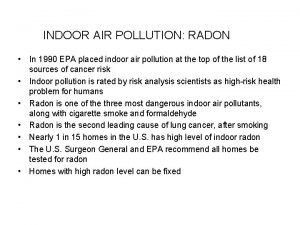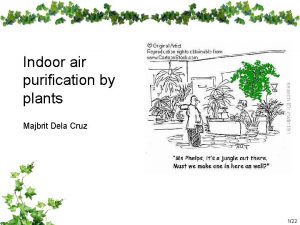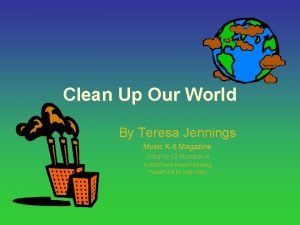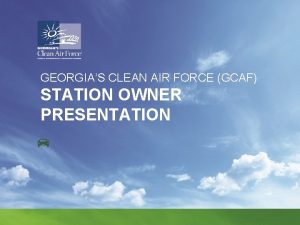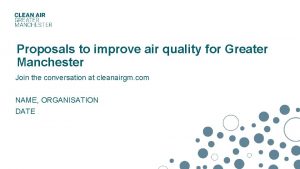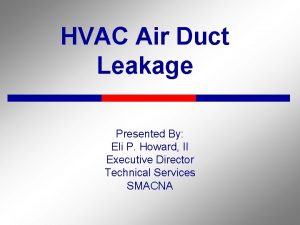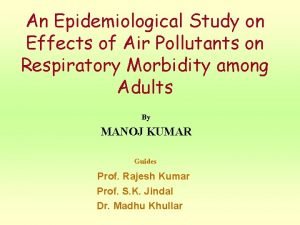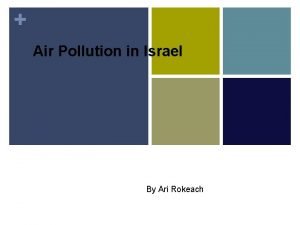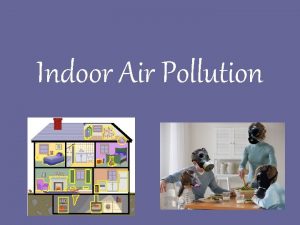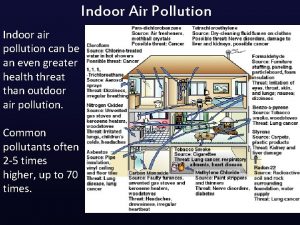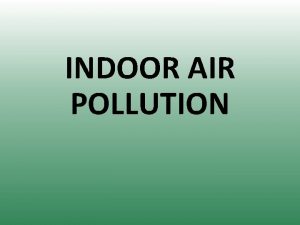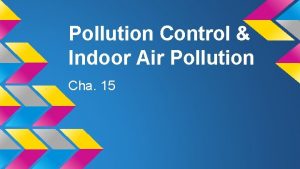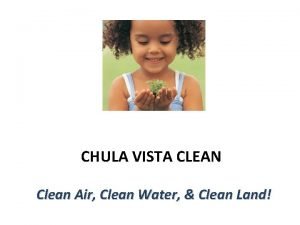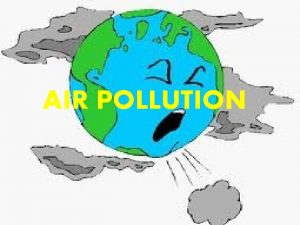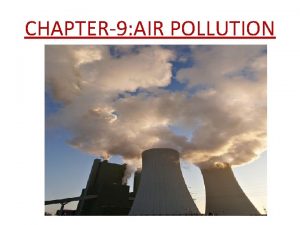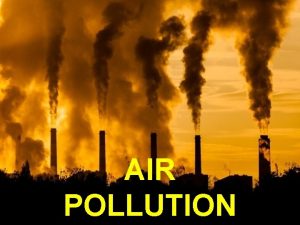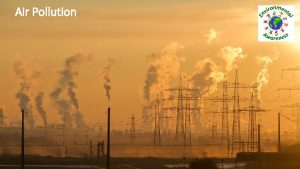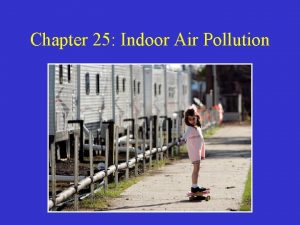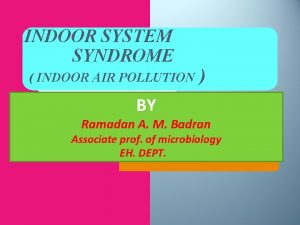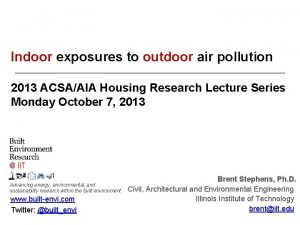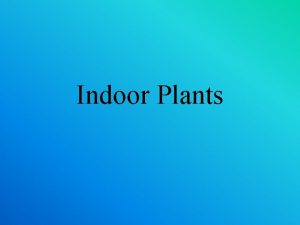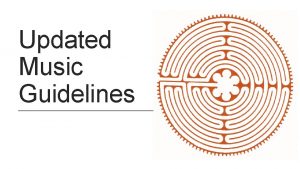INDOOR AND OUTDOOR AIR POLLUTION AND CLEAN AIR






















- Slides: 22

INDOOR AND OUTDOOR AIR POLLUTION, AND CLEAN AIR ACT Prof. Madi jaghbir

INDOOR AIR POLLUTION - OVERVIEW -People spend most of their time indoors. -The EPA has shown that indoor levels of some pollutants, such as formaldehyde, and chloroform, range from 2 to 50 times higher than outdoor levels. -Exposure to pollutants such as environmental tobacco smoke and radon occurs almost entirely indoors.

1. ENVIRONMENTAL TOBACCO SMOKE (ETS) The EPA has classified environmental tobacco smoke as a class A carcinogen, responsible for approximately 3, 000 lung cancer deaths and 62, 000 heart disease deaths annually in U. S. Remedial action: The most effective solution is to eliminate all smoking from the individual’s environment, either through smoking prohibitions or by restricting smoking to properly designed smoking rooms.

2. HEATERS, STOVES, FIREPLACES Releases carbon monoxide, nitrogen dioxide and particles Carbon Monoxide- colorless, odorless gas Nitrogen Dioxide- colorless, odorless gas Particles- released when fuels are incompletely burned

3. BIOLOGICAL CONTAMINANTS -Biological contaminants are mold, mildew, bacteria, pet dander, dust mites, and pollen -Humidity level in the home plays an important role in controlling the environment that some biological contaminants grow and thrive in -A safe home humidity level is 30 -50%

REMEDIAL ACTION Provide adequate outdoor air ventilation to dilute human source aerosols. Keep relative humidity below 50 percent. Keep equipment water reservoirs clean and potable water systems adequately chlorinated, according to manufacturer instructions. Maintain humidifiers and dehumidifiers according to manufacturer instructions.

4. VOLATILE ORGANIC COMPOUND(FORMALDEHYDE, PESTICIDES, SOLVENTS, CLEANING AGENTS) Formaldehyde: has been classified as a probable human carcinogen by the EPA. Pesticides : some pesticide active ingredients and inert components are considered possible human carcinogens. Remedial action: Increase ventilation when using products that emit volatile organic compounds. Formaldehyde: Identify the source, and if possible, remove it. If not possible, reduce exposure.

5. HEAVY METALS (AIRBORNE LEAD AND MERCURY VAPOR) Lead (Pb) is toxic, particularly impacting children (in the form of cognitive and developmental deficits). The Centers for Disease Control and Prevention has set 10 g/dl (blood lead level (Pb. B)) as the level of concern. The chief source is paint. elevated levels of mercury is found in interior latex paint.

6. LONG TERM RISKS (RADON) Radon: is the second leading cause of lung cancer, following smoking. It is present in high concentration in certain types of soil and rocks (e. g. granite) Since 1988, EPA has recommended that homes below the third floor be tested for radon. Corrective steps include sealing foundation cracks and holes, and venting radon-laden air from beneath the foundation.

MAJOR OUTDOOR AIR POLLUTANTS 1. 2. 3. 4. 5. Particulate matter Ozone Nitrogen oxides Carbon monoxide Sulfur dioxide

1. PARTICULATE MATTER Complex mixture of particles that can be solid, liquid or both Vary in size, composition, and origin Sources: 1. Power plants and industry 2. Motor vehicles, domestic coal burning 3. Natural sources (volcanoes, dust storms) 4. Small particles form surface for acid aerosol formation

OZONE “Secondary pollutant" Formed by photochemical reaction of VOCs, NO 2 + O 2 Peaks late afternoon Maximum in hot, stagnant air

NITROGEN OXIDES (NOX ): 1. 2. 3. SOURCES Power plants, industry Motor vehicles Natural sources (volcanoes, lightning, bacteria)

CARBON MONOXIDE (CO): 1. 2. 3. 4. SOURCES Incomplete combustion of fuels Vehicle exhaust Industry Fires

SULFUR DIOXIDE (SO 2 ) SOURCES Combustion of sulfur-containing coal or oil Industrial processes, smelting of sulfur-containing ores Natural sources (volcanoes) Combines with water to form H 2 SO 4 (acid aerosol, acid rain)


OUTDOOR AIR POLLUTION PREVENTION 1. 2. 3. 4. 5. Implement control mechanisms (emission inspections) Monitor air quality Inform the public of effective pollution reduction activities and associated health benefits Promote the use of clean, renewable energy sources , such as solar and wind-powered energy , and encourage the movement away from dirtier fuels, such as coal Encourage technological innovation to decrease emissions from stationary sources and conventional vehicles, and investigate alternative fuels

CLEAN AIR ACT


Under the clean air act EPA’s sets limits on certain air pollutants including setting limits on how much can be in the air any where in the U. S The clean air act has helped to cut dangerous pollutants clean up air pollution and production and use of chemicals that contribute to the hole in the ozone layer since 1980

Ground level ozone has reduced by more than 25% Sulfur dioxide has reduced by 71% Nitrogen dioxide has reduced by 46% Lead content in gasoline has reduced by 92% and levels of lead in the air has decreased by 94%

THANK YOU SOURCES www. epa. gov/air/caa/requirment. html https: //www. epa. gov/indoor-air-quality-iaq/indoor-airpollution-introduction-health-professionals-printableversion
 Indoor air pollution examples
Indoor air pollution examples Radon indoor air pollution
Radon indoor air pollution Prevention of indoor air pollution
Prevention of indoor air pollution Indoor air pollutants
Indoor air pollutants Sports indoor and outdoor
Sports indoor and outdoor Types of games outdoor
Types of games outdoor Indoor advertising meaning
Indoor advertising meaning Vrf system troubleshooting
Vrf system troubleshooting Clean up everybody let's clean up
Clean up everybody let's clean up Chapter 12 section 1 what causes air pollution answers key
Chapter 12 section 1 what causes air pollution answers key Chapter 12 air section 1 what causes air pollution
Chapter 12 air section 1 what causes air pollution Clean air act of 1990
Clean air act of 1990 Gcaf north
Gcaf north Manchester clean air zone
Manchester clean air zone Smacna duct leakage calculator
Smacna duct leakage calculator Clean air act philippines
Clean air act philippines Hubungan air dengan tanah
Hubungan air dengan tanah 2 causes of soil pollution
2 causes of soil pollution Soil pollution images diagram
Soil pollution images diagram Objective of pollution
Objective of pollution Examples of primary pollutants and secondary pollutants
Examples of primary pollutants and secondary pollutants Ari rokeach
Ari rokeach Aim and objectives of air pollution
Aim and objectives of air pollution

